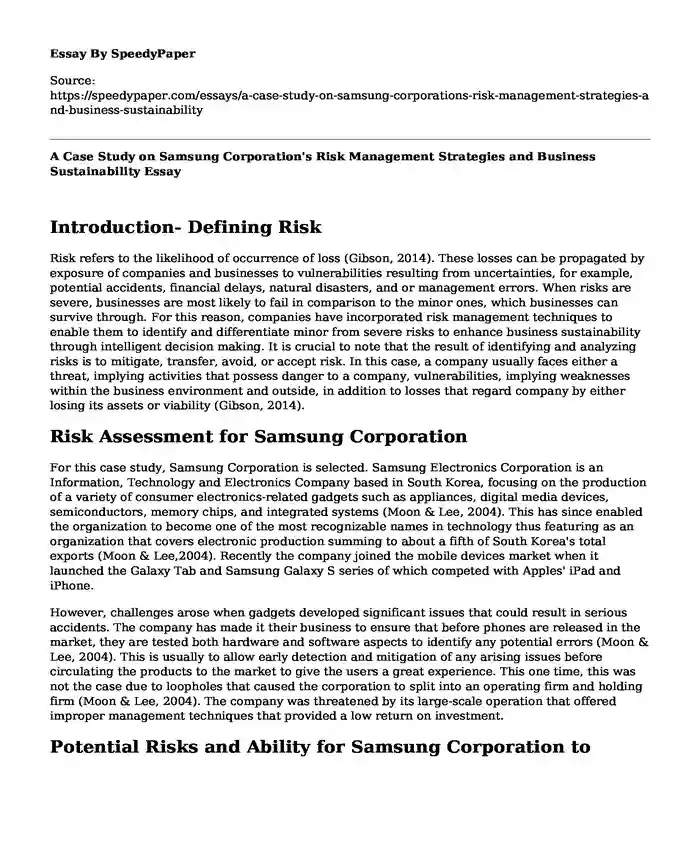
| Type of paper: | Case study |
| Categories: | Management Samsung Risk management |
| Pages: | 3 |
| Wordcount: | 622 words |
Introduction- Defining Risk
Risk refers to the likelihood of occurrence of loss (Gibson, 2014). These losses can be propagated by exposure of companies and businesses to vulnerabilities resulting from uncertainties, for example, potential accidents, financial delays, natural disasters, and or management errors. When risks are severe, businesses are most likely to fail in comparison to the minor ones, which businesses can survive through. For this reason, companies have incorporated risk management techniques to enable them to identify and differentiate minor from severe risks to enhance business sustainability through intelligent decision making. It is crucial to note that the result of identifying and analyzing risks is to mitigate, transfer, avoid, or accept risk. In this case, a company usually faces either a threat, implying activities that possess danger to a company, vulnerabilities, implying weaknesses within the business environment and outside, in addition to losses that regard company by either losing its assets or viability (Gibson, 2014).
Risk Assessment for Samsung Corporation
For this case study, Samsung Corporation is selected. Samsung Electronics Corporation is an Information, Technology and Electronics Company based in South Korea, focusing on the production of a variety of consumer electronics-related gadgets such as appliances, digital media devices, semiconductors, memory chips, and integrated systems (Moon & Lee, 2004). This has since enabled the organization to become one of the most recognizable names in technology thus featuring as an organization that covers electronic production summing to about a fifth of South Korea's total exports (Moon & Lee,2004). Recently the company joined the mobile devices market when it launched the Galaxy Tab and Samsung Galaxy S series of which competed with Apples' iPad and iPhone.
However, challenges arose when gadgets developed significant issues that could result in serious accidents. The company has made it their business to ensure that before phones are released in the market, they are tested both hardware and software aspects to identify any potential errors (Moon & Lee, 2004). This is usually to allow early detection and mitigation of any arising issues before circulating the products to the market to give the users a great experience. This one time, this was not the case due to loopholes that caused the corporation to split into an operating firm and holding firm (Moon & Lee, 2004). The company was threatened by its large-scale operation that offered improper management techniques that provided a low return on investment.
Potential Risks and Ability for Samsung Corporation to Function Vertically
Threats that face the company concerns competition from other electronics industry, consumer product imitation, and legal restrictions and lawsuits in addition to weaknesses regarding dependence on Android OS, the lack of a comprehensive platform for its hardware and software (Omer, 2019). These threats can be referred to as internal and external factors affecting the company where competition and product imitation are its greatest threats. Despite these issues, the company is exposed to a wide range of opportunities that has promoted its sustainability. These opportunities include strategic partnerships with software developers, strategic partnerships with online service firms, business growth through product development, and business growth through diversification (Omer, 2019). According to the company’s designs, development, and capabilities, and a strong technological background, it is easier to maneuver through business waves by strategic approaches that improve relationships. Therefore despite the risks associated with running this corporate, its managed to survive competition and rise above other electronic competitors, thus sustaining its business environment.
References
Gibson, D. (2014). Managing Risks in Information Systems
Moon, H. C., & Lee, D. (2004). The competitiveness of multinational firms: A case study of Samsung Electronics and Sony. Journal of International and Area Studies, 1-21.
Omer, S. K. (2019). SWOT analysis implementation's significance on strategy planning Samsung mobile company as an example. Journal of Process Management. New Technologies, 7(1), 56-62.
Cite this page
A Case Study on Samsung Corporation's Risk Management Strategies and Business Sustainability. (2024, Jan 24). Retrieved from https://speedypaper.net/essays/a-case-study-on-samsung-corporations-risk-management-strategies-and-business-sustainability
Request Removal
If you are the original author of this essay and no longer wish to have it published on the SpeedyPaper website, please click below to request its removal:
- Essay Example on Uber Cabs Business Model
- Essay Sample on Walmart Mergers or Acquisitions and Their Impact on Company Risk
- Essay Example on Rolls Royce and Nike Advertising
- Paper Example - Excellent Leadership Communication
- Essay Sample on Strategy: Coca Cola Company
- Paper Example: Amazon HRM Analysis
- Communication in Project Management - Free Essay Example
Popular categories




